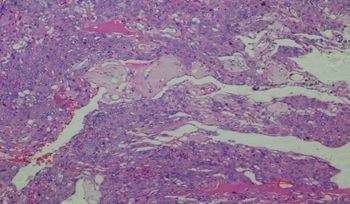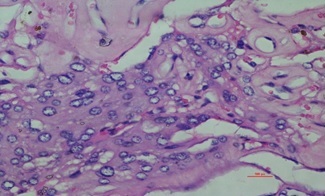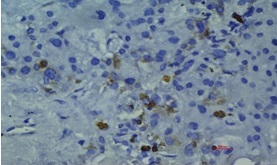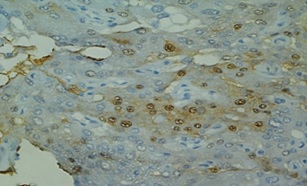Dysembryoplastic Neuroepithelial Tumor (Dnet) in a Young Female: A Rare Case Presentation
Download
Abstract
Dysembryoplastic neuroepithelial tumor (DNET) is a recently described, morphologically unique, and surgically curable low grade brain tumor which is included in the WHO CNS classification as neuronal and mixed neuronal glial tumor. It is usually seen in children and young adults. This entity first described by Damas-Duport in 1998 is usually non-recurring with an excellent prognosis. We present a case of 30 year old female experiencing seizures with well defined space occupying lesion in the frontal region of brain. Contrast enhanced Magnetic Resonance Imaging was done which revealed well defined multilobulated solid cystic mass lesion in cortical/ subcortical region of left frontal lobe. Histological features suggested dysembryoplastic neuroepithelial tumor which was subsequently confirmed on immunohistochemistry by GFAP and S-100 positivity. The principal differential diagnosis is oligodendrogliomas and gangliogliomas. Patient did not receive any adjuvant therapy post operatively and showed no signs of residual disease or recurrence on magnetic resonance imaging during follow up. Patient is on phenytoin for prophylaxis of seizures.
Introduction
Dysembryoplastic neuroepithelial tumors (DNETs) are morphologically unique benign mixed glioneural neoplasms occurring in pediatric age group. Incidence among all neuroepithelial tumors is 1.2% in patients under 20 years and 0.2% in age over 20 years [1]. Originally described by Damas-Duport in 1998 and are characterized histologically by the presence of oligodendrocyte-like cells [2,3]. This entity is usually nonrecurring, surgically curable with an excellent prognosis [1].
We report a case of young female patient who presented with history of seizures and later on magnetic resonance imaging studies revealed well defined solid cystic mass which was resected and submitted for histopathological examination which suggested a low grade glioma favouring DNET.
Case presentation
A 30 year old female presented to the Neurosurgery out patient department with history of epileptic seizures on and off without any history of neurological deficits for the past 4 months. There was no history of headache, projectile vomiting, difficulty in speech, ataxia or gait disturbances and sensory-motor deficits.
Contrast enhanced Magnetic Resonance Imaging was done which revealed well defined multilobulated solid cystic mass lesion in cortical/subcortical region of left frontal lobe. Patient underwent local resection surgery and a well defined moderately vascular space occupying lesionwas identified in left frontal region and resected.
The tissue specimen was then submitted for histopathological examination which appeared well circumscribed, soft in consistency measuring 2x2x0.5cm in dimension. Microscopy showed cytoarchitectural disorganisation of tumor cells with large pleomorphic tumor cells with coarse clumped chromatin with moderate eosinophilic cytoplasm admixed with few oligodendrocyte like cells interspersed with congested blood capillaries (Figure 1 and 2).
Figure 1. Microscopy Showed Cytoarchitectural Disorganisation of Tumor Cells with Large Pleomorphic Tumor Cells Admixed with Few Oligodendrocyte Like Cells Interspersed with Congested Blood Capillaries. Heamatoxylin and Eosin x 10X.

Figure 2. The Tumor Cells Showed Coarse Granular chromatin with Moderate Indistinct Eosinophilic Cytoplasm Admixed with Congested Blood Vessels. Heamatoxylin and Eosin x 40X.

Focal areas of myxoid change and haemorrhage also appreciated. Ki-67 showed positivity in 5-6% of tumor cells. Immunohistochemistry for GFAP showed sparsely cytoplasmic positive astroglial elements (Figure 3).
Figure 3. Immunohistochemistry for GFAP Showed Sparsely Cytoplasmic Positive Astroglial Elements. IHC GFAPx40X.

The oligodendrocyte like cells showed mild S-100 cytoplasmic positivity (Figure 4).
Figure 4. The Oligodendrocyte Like Cells Showed Mild S-100 Cytoplasmic Positivity. IHC S-100x 40X.

Based on histopathology and immunohistochemistry findings diagnosis of low grade glioma favouring dysembryoplastic neuroepithelial tumor (DNET) was made. Patient did not receive any adjuvant therapy post operatively and showed no signs of residual disease or recurrence on magnetic resonance imaging during follow up. Patient is on phenytoin for prophylaxis of seizures.
Discussion
DNETs are low-grade, mixed neuronal-glial neoplasms that are common in the pediatric age group [4]. They were originally described in 1998 by Damas-Duport as a group of supratentorial cortical benign lesions associated with early-onset epilepsy in children and young adults with a slight male predominance [2].
The tumors typically range from 10 to 25 mm in size and are usually located in the mesial temporal lobe, but frontal and parieto-occipital lobe lesions are also common [5]. Both computerized tomography (CT) and MRI scans usually show cortical cystic or multicystic lesions [4]. Cystic changes and calcifications are common. Histology is characterized by the presence of small round cells referred to as oligodendroglia-like cells (OLCs) in an abundant mucinous matrix with “floating neurons” without dysplasia [4].
The principal differential diagnosis is oligodendrogliomas and gangliogliomas.
Oligodendroglioma is located in cortex and white matter [6]. Oligodendroglioma is generally round to oval appearing as a relatively well-circumscribed mass of variable size and shows variable signal intensity adding to the heterogeneous appearance of the tumour on MRI [7,8]. The hallmark features of oligodendroglioma are the presence of calcification and a cortical-subcortical location [9]. The absence of floating neurons with GFAP and synaptophysin negativity can help in ruling out the oligodendroglioma. Gangliogliomas are, however, positive for GFAP and synaptophysin but radiologically present as a cystic mass with mural nodule. They show neoplastic ganglion cells and perivascular lymphocytic infiltrate [6].
Histogenesis of DNETs is debatable and not clearly known. Associated dysplastic features in the form of cortical dysplasia, atypical clusters of neurons and glial cells, and doubling of fascia dentata of the hippocampus favour the dysplastic nature of these lesions [10-12].
Surgery remains the mainstay of treatment. The therapeutic goal is to excise the tumor to control the epilepsy. After complete removal, DNET has a favourable prognosis without recurrence [2,13]. However, the presence of a residual tumor is .a high-risk factor for tumor and seizure recurrence [14]
In conclusions, DNET is a benign non-recurring low grade glioma affecting young adults. Usually the patients present with epileptogenic seizures. It can mimic the features of oligodendroglioma, pilocytic astrocytoma and ganglioglioma serving as its close differentials. Therefore careful examination of the entire tissue specimen should be done before giving the diagnosis of its differentials. Identification and establishing correct diagnosis of this tumor is necessary for therapeutic and prognostic interest of the patient so that they are spared from deleterious effects of chemo and radiation therapy.
References
- Dysembryoplastic neuroepithelial tumor: A rare brain tumor not to be misdiagnosed Sukheeja D, Mehta J. Asian Journal of Neurosurgery.2016;11(2). CrossRef
- Dysembryoplastic neuroepithelial tumor: a surgically curable tumor of young patients with intractable partial seizures. Report of thirty-nine cases Daumas-Duport C, Scheithauer BW , Chodkiewicz JP , Laws ER , Vedrenne C. Neurosurgery.1988;23(5). CrossRef
- Septal dysembryoplastic neuroepithelial tumor: a comprehensive clinical, imaging, histopathologic, and molecular analysis Chiang JCH , Harreld JH , Tanaka R, Li X, Wen J, Zhang C, Boué DR , et al . Neuro-Oncology.2019;21(6). CrossRef
- Dysembryoplastic Neuroepithelial Tumors: What You Need to Know Luzzi S, Elia A, Del Maestro M, Elbabaa SK , Carnevale S, Guerrini F, Caulo M, Morbini P, Galzio R. World Neurosurgery.2019;127. CrossRef
- Dysembryoplastic Neuroepithelial Tumors Suh YL . Journal of Pathology and Translational Medicine.2015;49(6). CrossRef
- Malignant transformation of a dysembryoplastic neuroepithelial tumor. Case report Hammond RR , Duggal N, Woulfe JM , Girvin JP . Journal of Neurosurgery.2000;92(4). CrossRef
- Osborn's brain imaging pathology anatomy. Salt Lake City,UT:Amirsys,Inc. 3rd edition.Lippincott, Williams & Wilkins, Philadelphia, PA Osborn A. 2012;:1208-1213.
- From the archives of the AFIP: Oligodendroglioma and its variants: radiologic-pathologic correlation Koeller KK , Rushing EJ . Radiographics: A Review Publication of the Radiological Society of North America, Inc.2005;25(6). CrossRef
- Molecular genetics, imaging and treatment of oligodendroglial tumours Jenkinson MD , Walker C, Brodbelt AR , Wilkins S, Husband D, Haylock B. Acta Neurochirurgica.2010;152(11). CrossRef
- Dysembryoplastic neuroepithelial tumors. Brain Pathol.1993;3:283-95. 11.Prayson RA, Estes ML, Morris HH. Coexistence of neoplasia and cortical dysplasia in patients presenting with seizures. Epilepsia Daumas-Duport C. 34.1993;:609-615.
- Coexistence of neoplasia and cortical dysplasia in patients presenting with seizures Prayson RA , Estes ML , Morris HH . Epilepsia.1993;34(4). CrossRef
- Dysembryoplastic neuroepithelial tumor. Features in 16 patients Raymond AA , Halpin SF , Alsanjari N, Cook MJ , Kitchen ND , Fish DR , Stevens JM , et al . Brain: A Journal of Neurology.1994;117 ( Pt 3). CrossRef
- Dysembryoplastic neuroepithelial tumour. In: Louis DN, Oghaki H, Wiestler D, Cavenee WK .4th edition. WHO classification of tumours of the central nervous system. WHO Press, Geneva Daumas-Duport C, Pietsch T, Hawkins C, Shankar SK . 2007;:99-102.
- Long-term seizure outcome following surgery for dysembryoplastic neuroepithelial tumor Chan CH , Bittar RG , Davis GA , Kalnins RM , Fabinyi GCA . Journal of Neurosurgery.2006;104(1). CrossRef
License

This work is licensed under a Creative Commons Attribution-NonCommercial 4.0 International License.
Copyright
© Asian Pacific Journal of Cancer Care , 2023
Author Details
How to Cite
- Abstract viewed - 0 times
- PDF (FULL TEXT) downloaded - 0 times
- XML downloaded - 0 times